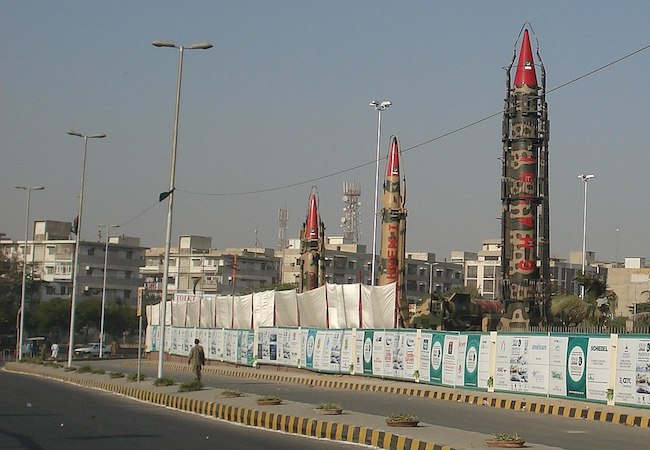Pakistan’s test of Ghaznavi Missile: Vindicating minimum deterrence posture

By Haris Bilal Malik
In recent years, there has been a profound development of the nuclear-capable missile systems in South Asia. This is mainly initiated by India since it has been maintaining an offensive nuclear posture vis-à-vis Pakistan. In this regard, India is involved in an all-encompassing modernization of its nuclear warhead delivery systems. These include; land, sea, and air-launched ballistic missiles and cruise missiles that are capable of delivering nuclear warheads. India has operationalized some of the advanced ballistic and cruise missiles having short, medium, and long ranges. For instance, the Nirbhay cruise missile and the most advanced BrahMos supersonic cruise missile launch-able from air, land, and sea are among the others. Furthermore, various versions of the Prithvi missile are India’s operational short-range ballistic missiles. The Agni series ballistic missiles have ranges of medium to intermediate and most notably the Agni-V and Agni-VI are reportedly the ‘Inter Continental Ballistic Missile’ (ICBMs). Likewise, the different versions of K-series missiles are the much-hyped submarine-launched ballistic missiles in the Indian inventory. The presence of a diverse type of warhead delivery system in the Indian nuclear arsenal has significantly added to the threat spectrum of Pakistan. Consequently, it has compelled Pakistan to develop its nuclear warhead delivery system to a minimum and credible level that would deter India.
Pakistan’s development of missile systems is in-line with the posture of credible minimum nuclear deterrence. This covers a broad spectrum of threats coming from India including its conventional and unconventional military modernization and its offensive nuclear posture against Pakistan. At the present, Pakistan’s missile inventory includes a diverse type of missiles that are capable of delivering conventional and nuclear warheads at various ranges. These include; tactical or battlefield ballistic missiles ‘Nasr’ and ‘Abdali’, short-range missiles ‘Ghaznavi’ and Shaheen-1, medium-range Ghauri-I and Ghauri-II, Shaheen-II and Shaheen-III and Ababeel ballistic missiles. Pakistan also has advanced cruise missiles like Babur and Ra’ad that can be launched from air, land, and sea. Pakistan frequently conducts tests of its missiles to assess the operational readiness and accuracy of these delivery systems.
Very recently, on February 3, 2021, Pakistan conducted a test of its short-range ballistic missile Ghaznavi. The missile can deliver both nuclear and conventional warheads within the range of 290 kilometers. The latest test of Ghaznavi was a night training launch test as part of the annual exercise in the field. Training launch refers to that the nature of the test is meant to evaluate the missile under various parameters of accuracy since the missile is already in operational mode. In this case, the test launch was aimed at assessing the handling and operational readiness of the missile specifically at night time. The Ghaznavi missile is one of the oldest and accurate solid-fueled and road-mobile short-range delivery systems in Pakistan’s inventory. It is a guided missile that is equipped with a terminal guidance system that makes it one of the complex missile systems for delivering a nuclear warhead.
Furthermore, the Ghaznavi missile system, specifically since its tests in recent years has been speculated to have ‘multiple independent reentry vehicle’ (MIRV) capabilities. Regardless of such speculation, many experts maintain that Pakistan needs to have a MIRV capable short-range ballistic missile. This has become more significant especially considering the Indian counterforce aspirations vis-à-vis Pakistan. India’s offensive nuclear posture and counterforce military modernization highlight that it has been shifting its posture more towards a counterforce nuclear doctrine. The Indian much-hyped notions of ‘surgical strikes’ that can also include a ‘splendid first strike’ further suggest India’s counterforce temptations against Pakistan. Furthermore, India’s development of advanced air defence systems ingeniously and the acquisition of some of the most advanced air defence systems like the Russian S-400 would likely provoke Pakistan to maintain a least possible countermeasure. In this regard, given the accuracy and short range of the Ghaznavi ballistic missile, its prospective MIRV capability could become a reliable platform in the short-range delivery systems that can penetrate India’s advanced air defence shield. This provision in turn along with the Ababeel medium-range MIRV capable ballistic missile would further add to Pakistan’s deterrence posture against India’s provocative air defence shield.
It is notably important to know that Pakistan’s nuclear capability and its nuclear doctrine are meant to ensure the security and preserve the sovereignty of the country. It is aimed at deterring India from any kind of aggression. In this regard, the development and up-gradation of nuclear warhead delivery systems are all in line with the principle of credible minimum nuclear deterrence. The development of tactical, short, and medium-range missiles and the provision of an ensured second-strike capability have significantly added to Pakistan’s deterrence posture. Consequently, they have denied the space for a limited and low-intensity conflict initiated by India. This has also ensured the regional equation of the nuclear deterrence equilibrium.
Summarizing it all, the prevalent security environment of the South Asian region which India aspires to dominate with its provocative war strategies and offensive nuclear posture poses a serious threat to Pakistan’s security. This is further evident from its ongoing extensive military modernization both at the conventional and unconventional levels. Such Indian aspirations are aimed at undermining the pre-existing regional deterrence equilibrium that has been ensured by Pakistan’s nuclear capability over the years. In this regard, Pakistan needs to preserve the nuclear deterrence equation while staying within its existing deterrence posture. The recent test of the Ghaznavi missile has further vindicated the full spectrum deterrence within the ambit of credible minimum nuclear deterrence. This seems to be an appropriate manifestation of Pakistan’s resort to respond.
Haris Bilal Malik works as a Research Associate at the Strategic Vision Institute (SVI) in Islamabad, Pakistan.




